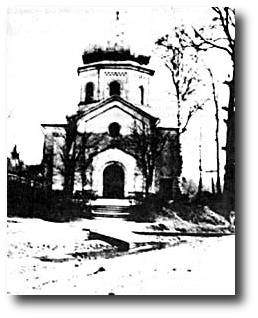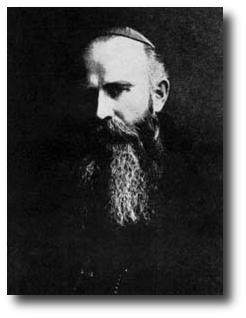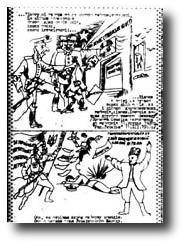![[LITOPYS UPA: Chronicle of the Ukrainian Insurgent Army]](/upa/images/litopys.jpg)
SERIES 1
VOLUME 17
![[LITOPYS UPA: Chronicle of the Ukrainian Insurgent Army]](/upa/images/litopys.jpg)

 All documents in this volume come from the Zakerzons'kyi
Krai - Ukrainian ethnographic territories west of the Curzon Line -
which at the Yalta Conference were given to Poland. I discovered them
in the National Archives of the United States in 1982. They had been
reclassified from the "secret" category, and were made available for
general use.
All documents in this volume come from the Zakerzons'kyi
Krai - Ukrainian ethnographic territories west of the Curzon Line -
which at the Yalta Conference were given to Poland. I discovered them
in the National Archives of the United States in 1982. They had been
reclassified from the "secret" category, and were made available for
general use.
How they came to the West is also quite interesting. They are part of a larger group of documents that in the years 1946-1947 were sent by special couriers of the Ukrainian underground leadership, in most cases women, to various Western embassies in Warsaw, including the embassy of the United States. [1]
Transmitted to Washington by the U.S. Military Attache, they make up a relatively large group of documents (Record Group 319), of the Assistant Chief of Staff, Intelligence (G2). [2]
Because there exists a great deal of scepticism in connection with the Ukrainian underground publications even among the highly knowledgeable and objective scholars in the West, the discovery of these documents in the U.S. Archives removes any doubt as to their authenticity. [3]
A large number of the Ukrainian language publications from this collection of documents were published in volume 16 of the Litopys UPA, devoted to underground journals from Ukraine beyond the Curzon Line. In this volume we are reprinting only the English language materials in the following order: "New Lidice", which documents the brutal destruction by the Polish Army of the Ukrainian Lemko village of Zavadka Morokhivs'ka: "The Displacement of His Excellency Bishop Josaphat Kotsylovsky and Ukrainian Catholic Clergy of Peremyshl", which describes the forcible exile of the Bishop to the USSR where he died in prison, the consequent liquidation of this ancient Bishopric, the act of desecration of the cathedral, the wholesale looting of religious objects, and the destruction of the church property and its valuable archives.
Both of these documents were published in 1946, shortly after the events described in the took place. Neither document has an individual author and both are signed the "Representatives of the Ukrainain Population Living Beyond the Curzon Line". They were based on the facts collected by the underground and probably drafted either by Vasyl Halasa ("Orlan"), the Chief of Propaganda, or by Iaroslav Starukh ("Stiah", "Stoiar", "Iarlan"), the OUN leader, who mentions the tragic events in Zavadka Morokhivs'ka in his article in Infomator, No. (11), 1946. [4]
 A third document, Elections in the U.S.S.R. was written by
Iaroslav Starukh in January 1947. It was reprinted in Ukrainian in the
March 1947 issue of the Journal Informatyvni Visti, and was also
translated and published in January 1947 in English.
[5]
A third document, Elections in the U.S.S.R. was written by
Iaroslav Starukh in January 1947. It was reprinted in Ukrainian in the
March 1947 issue of the Journal Informatyvni Visti, and was also
translated and published in January 1947 in English.
[5]
The brochure New Famine Catastrophe in Ukraine was also written by Iaroslav Starukh ("Stoiar"). He completed it sometime in 1946, and in January 1947 it was translated into English and published. [6]
The author analyzes the situation in Ukrainian agriculture and characterizes the famines of 1921-23 and 1932-33 as an instrument of Soviet policy used against the Ukrainian population which was hostile to the regime. The famine of 1946-47 is seen by him as the continuation or the use of the well-tried method of the Soviet government against the recalcitrant population, especially in Eastern Ukraine. There the threat of retaliation from the Ukrainian underground was non-existent.
Iarosalv Starukh ("Iarlan") is also the author of Spectre of Fascism. The Ukrainian language edition of this brochure is lost and is not available. In the West there exists a Polish version of the brochure from 1946, reprinted in one of the volumes of Litopys UPA, and in the book Political Thought of the Ukrainian Underground: 1943-1951. [7]
This English language edition from January 1947 (File 356 391) is being published here for a first time. In it the author describes and analyzes the basic characteristics of totalitarian regimes of a fascist type, and by way of a comparative method shows that the USSR functions on exactly the same principles. In his view, Italian Fascism, German Naziism, and Russian Bolshevism are identical totalitarian movements and systems that appeared in various European countries after World War One. It should be mentioned, that this essay of great theoretical importance was written in an underground bunker some ten years earlier than the book Totalitarian Dictatorship and Autocracy, which placed into circulation a concept of totalitarianism which had profound influence on a wide circle of western intellectuals. [8]
To Brotherly Czech and Slovak Nations, appeared in Ukrainian and Czech languages in 1946. This translation from January 1947 (File 356 391) is signed "The Ukrainian Insurgents". It may have been written either by laroslav Starukh or more likely Vasyl Halasa. The latter in his capacity as the Chief of Propaganda had a clear responsibilityfor contacts with the neighbouring peoples. [9]
In this brochure the author describes the policy of Russian imperialists vis-a-vis the Ukrainian nation and its struggle for freedom. The political program of the Ukrainian liberation movement is also clearly outlined. The author or authors warn the Czechs and Slovaks not to minimize the Soviet policy with respect to their country and call upon them to join the common struggle against the Russian invaders for the rights of nations and man.
Although the materials of this volume differ, their contents form a remarkably unified whole pertaining to the ideological positions of the Ukrainian liberation movement during and immediately after World War Two.
 In contrast with similar editions of these brochures in Slavic
languages and in French, the language of the documents reprinted here
is rather poor. It is quite clear that the individuals who make these
translations did not have sufficient proficiency in English language
or grammar. Moreover in their work, they probably had to rely on an
inadequate Ukrainian-English or perhaps a Polish-English
dictionary. The average English reader no doubt would have great
difficulty in understanding the texts of these documents. However,
even with these severe limitations and obstacles, the translators did
succeed in conveying to a thoughtful English reader, the main ideas of
the Ukrainian liberation movement.
[10]
In contrast with similar editions of these brochures in Slavic
languages and in French, the language of the documents reprinted here
is rather poor. It is quite clear that the individuals who make these
translations did not have sufficient proficiency in English language
or grammar. Moreover in their work, they probably had to rely on an
inadequate Ukrainian-English or perhaps a Polish-English
dictionary. The average English reader no doubt would have great
difficulty in understanding the texts of these documents. However,
even with these severe limitations and obstacles, the translators did
succeed in conveying to a thoughtful English reader, the main ideas of
the Ukrainian liberation movement.
[10]
We are reprinting these materials here as documents of the period, without in any way, altering their form or content. The language of these publications was left without change and only in some places were short explanations offered in the form of footnotes.
What kind of influence did these works have on the formation of political opinions among the circles for which they were written? Have they performed their function as the source of information about the Ukrainian liberation movement? These questions are difficult to answer but on this score, one is left with serious doubts. Rendered in a rather awkward English, and in the absence of a favourable political atmosphere, these publications failed to break through to the world public opinion, as we fervently hoped for by the underground leadership. As such, they found themselves gathering dust in the secret vaults in the archives of Western democracies.
Their historical value did not dimish, however. And it is hoped that by reappearing here, they will in time attract attention of a serious researcher and historian, and although in a somewhat belated fashion, will help contribute to the understanding of the latest armed struggle for freedom by the Ukrainian people.
* * *
All who contributed to the publication of this volume deserve our sincere thanks. First of all, we are grateful to Mr. W. G. Lewis for help in finding these documents in the U.S. National Archives, and his willingness to reclassify them in a prompt fashion. Mr. Wolodmyr Makar deserves special thanks for the onerous job of a proofreader and Mr. Stepan Shpak, for help in compiling the index.
Petro J. Potichnyj
Lev Shankov'skyi, in his bibliography mentioned above, lists 5 brochures, and 9 leaflets and proclamations in foreign languages published int he territories beyond the Curzon Line. However, as he himself readily admits, it is not a full count by any means. A list located int he National Archives of the United States (File 356 391), entitled Chytaite i poshyriuite ukrainsk'ki revoliutsiini vydannia, n.d. (Circa 1947), 8 pages, provides a parital listing of the underground publications for the years 1945-46. In this register there are 7 brochures, (among 25), and 10 (among 41) leaflets and proclamations in foreign language other than Russian. They are:
The leaflets and proclamations:
In addition there existed also the following publications: